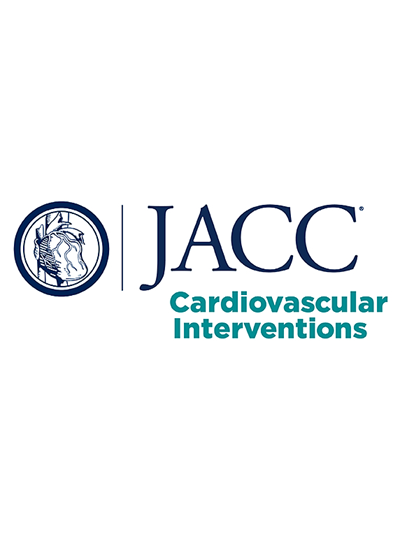Clinical Relevance of Discordance Between Physiology- and Imaging-Guided PCI Strategies in Intermediate Coronary Stenosis
IF 11.7
1区 医学
Q1 CARDIAC & CARDIOVASCULAR SYSTEMS
引用次数: 0
Abstract
Background
Recent randomized clinical trials have demonstrated the benefits of intravascular imaging (IVI)-guided percutaneous coronary intervention (PCI) over angiography-guided PCI. However, the role of angiography-based physiological assessment during IVI-guided PCI remains unclear.
Objectives
This study aimed to explore the discrepancies and significance of angiography-based physiological assessments in IVI-guided PCI.
Methods
In the international multicenter randomized FLAVOUR (Fractional Flow Reserve and Intravascular Ultrasound for Clinical Outcomes in Patients With Intermediate Stenosis) trial, angiography-based physiological assessment was retrospectively performed using the Murray law–based quantitative flow ratio (μQFR). In this post hoc analysis, patients were categorized based on intravascular ultrasound (IVUS)-guided treatment decisions (PCI or deferral) and μQFR as follows: negative μQFR with deferral of PCI (DEFER), negative μQFR with PCI (PERFORM), and positive μQFR with PCI (REFERENCE). The primary outcome was major adverse cardiovascular events, defined as a composite of death, myocardial infarction, and target vessel revascularization at the 24-month follow-up.
Results
Of the 784 patients, 34.4% (270/784), 29.3% (230/784), and 31.5% (247/784) were categorized into the DEFER, PERFORM, and REFERENCE groups, respectively. Physiological assessment led to substantial reclassification, encompassing 48.2% (230/477) of patients who underwent IVUS-guided PCI. The REFERENCE group showed a higher risk for major adverse cardiovascular events at 2 years compared with the PERFORM group (adjusted HR: 2.46; 95% CI: 1.13-5.35; P = 0.023). However, the primary outcomes in the DEFER and PERFORM groups were similar (adjusted HR: 0.88; 95% CI: 0.37-2.11; P = 0.779). The quality of life at 2 years was comparable among the 3 groups (P = 0.198).
Conclusions
Angiography-based physiological assessments can offer additional prognostic insights for patients undergoing IVI-guided PCI. IVUS-guided PCI may not be advantageous in patients with functionally insignificant lesions.
在中度冠状动脉狭窄中,生理和影像学引导下PCI治疗策略不一致的临床意义。
背景:最近的随机临床试验表明,血管内成像(IVI)引导下的经皮冠状动脉介入治疗(PCI)优于血管造影引导下的PCI。然而,基于血管造影的生理评估在ivi引导下PCI中的作用尚不清楚。目的:本研究旨在探讨血管造影生理评估在ivi引导下PCI中的差异及意义。方法:在国际多中心随机化的FLAVOUR (Fractional Flow Reserve and Intravascular Ultrasound for Clinical Outcomes In Patients With Intermediate Stenosis)试验中,采用基于Murray定律的定量血流比(μQFR)回顾性进行血管造影生理评估。在本事后分析中,患者根据血管内超声(IVUS)引导的治疗决策(PCI或延期)和μQFR进行分类:μQFR阴性伴PCI (DEFER), μQFR阴性伴PCI (PERFORM), μQFR阳性伴PCI (REFERENCE)。主要结局是主要心血管不良事件,定义为24个月随访时的死亡、心肌梗死和靶血管重建术的复合。结果:784例患者中,分别有34.4%(270/784)、29.3%(230/784)和31.5%(247/784)被分为DEFER组、PERFORM组和REFERENCE组。生理评估导致大量重新分类,包括48.2%(230/477)接受ivus引导的PCI的患者。与PERFORM组相比,REFERENCE组在2年时发生主要不良心血管事件的风险更高(调整HR: 2.46;95% ci: 1.13-5.35;P = 0.023)。然而,DEFER组和PERFORM组的主要结局相似(调整后风险比:0.88;95% ci: 0.37-2.11;P = 0.779)。3组患者2年时的生活质量具有可比性(P = 0.198)。结论:基于血管造影的生理评估可以为接受ivi引导的PCI患者提供额外的预后见解。ivus引导下的PCI对于功能无关紧要的病变患者可能并不有利。
本文章由计算机程序翻译,如有差异,请以英文原文为准。
求助全文
约1分钟内获得全文
求助全文
来源期刊

JACC. Cardiovascular interventions
CARDIAC & CARDIOVASCULAR SYSTEMS-
CiteScore
11.60
自引率
8.80%
发文量
756
审稿时长
4-8 weeks
期刊介绍:
JACC: Cardiovascular Interventions is a specialist journal launched by the Journal of the American College of Cardiology (JACC). It covers the entire field of interventional cardiovascular medicine, including cardiac, peripheral, and cerebrovascular interventions. The journal publishes studies that will impact the practice of interventional cardiovascular medicine, including clinical trials, experimental studies, and in-depth discussions by respected experts. To enhance visual understanding, the journal is published both in print and electronically, utilizing the latest technologies.
 求助内容:
求助内容: 应助结果提醒方式:
应助结果提醒方式:


